Acupuncture, Moxibustion, and Anma/Massage/Shiatsu Course
Integrating the wide range of oriental medicine
| Class | Capacity | Duration | Class Times | Days |
|---|---|---|---|---|
| Day | 30 people | 3 years | 9:30-12:40 (9:30-11:00, 11:10-12:40) | Mon. – Fri. |
| Night | 30 people | 3 years | 18:00-21:10 (18:00-19:30, 19:40-21:10) | Mon. – Fri. |
Examination Eligibility Granted on Completion
On successful completion of the course, students gain eligibility to sit the following national examinations: acupuncture, moxibustion, and anma/massage/shiatsu.
See with your hands!
Study a well-balanced blend of acupuncture, moxibustion, and anma/massage/shiatsu techniques
Students in this course learn a well-balanced curriculum of acupuncture, moxibustion, and anma techniques that originated in ancient China. The objective of the course is to develop medical professionals capable of applying a wide range of techniques to treat various conditions. Instructors have a wealth of experience in clinical settings. Under these instructors, Toyoshinkyu provides students with classes focused on clinical applications, progressing from basic knowledge in Western and Eastern medical traditions to practicum classes on acupuncture, moxibustion, and manual therapies.
Toyoshinkyu has produced clinical practitioners capable of responding to societal needs, practitioners who are high quality medical practitioners that possess the knowledge needed to be active in modern society, knowledge that includes consideration for patients and accurate decision-making capabilities.
Toyoshinkyu places special emphasis on the te-ate (treatment, lit. “laying on of hands”) aspects of anma, massage, and shiatsu. Our curriculum is unique for deeply integrating the importance of touch. In particular, acquiring Toyoshinkyu’s traditional technique of suji-momi (meridian anma) makes it possible to successfully determine the acupoints that are the key to providing treatments. Moreover, accurately determining these acupoints makes it possible to determine abnormalities of the body.
In the third year clinical practicum we provide instruction on how to treat a standard patient, using a method that comprehensively incorporates acupuncture, moxibustion, and anma/massage/shiatsu techniques.
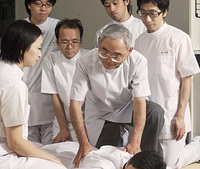
Holding anma techniques classes in a tatami mat practicum room allows for the development of clinical practitioners who are able to provide treatments in any environment.
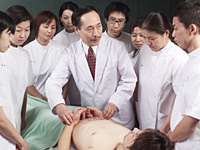
The four traditional diagnostic methods of oriental medicine are performed to determine the state of the body before needle insertion. Pulse diagnosis is the foundation.
Curriculum
| Category | Acupuncture and Moxibustion Course | Acupuncture, Moxibustion, and Anma/Massage/Shiatsu Course |
|---|---|---|
| General Basic Subjects | Nutrition, Medical English, Health and Physical Education, Ethics and Psychology, Chinese Classics | |
| Specialized Basic Subjects | Anatomy, Physiology, Introduction to Pathology, General Clinical Medicine, Applied Clinical Medicine, Rehabilitative Medicine, Hygiene and Public Sanitation | |
| Specialized Subjects | Acupuncture and Moxibustion Theory Introduction to Oriental Medicine Introduction to Acupuncture Meridians and Points Clinical Theory of Oriental Medicine Regional Manual Therapies and the Business Management of Manual Therapies Basic Acupuncture and Moxibustion Technique Acupuncture and Moxibustion Technique Practicum (Fundamental) Clinical Practicum DiagnosticsGeneral Applied (Laws and Ordinances) General Applied (Medical Fundamentals) General Applied (Clinical Medicine) General Applied (Oriental Medicine) Comprehensive Practical Training in Acupuncture and Moxibustion Anma/Massage/Shiatsu Theory |
Introduction to Oriental Medicine Introduction to Acupuncture Meridians and Points Clinical Theory of Oriental Medicine Regional Manual Therapies and the Business Management of Manual Therapies Basic Acupuncture and Moxibustion Technique Acupuncture and Moxibustion Technique Basic Anma/Massage/Shiatsu Technique Anma/Massage/Shiatsu Technique Practicum (Fundamental) Clinical Practicum DiagnosticsGeneral Applied (Laws and Ordinances), General Applied (Medical Fundamentals), General Applied (Clinical Medicine), General Applied (Oriental Medicine), Comprehensive Practical Training in Manipulative Therapies |
* Course content may vary slightly by academic year
A Message from Toyoshinkyu Teachers
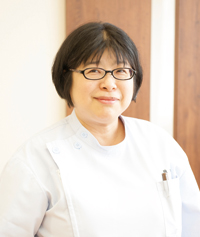
Keiko Taneda, Department Chair
Acupuncture, Moxibustion, and Anma/Massage/Shiatsu Course
Aim to become an oriental medicine generalist
The Acupuncture, Moxibustion, and Anma/Massage/Shiatsu Course aims to foster generalists who are capable of being active in a wide range of fields, people who can utilize the knowledge, diagnostic methods, and techniques of Oriental and Western medicine. I recommend this course for people who know they want to comprehensively utilize acupuncture, moxibustion, and anma/massage/shiatsu in clinical settings. I also recommend this course to people who want to learn acupuncture, moxibustion, and anma/massage/shiatsu, but still want time to consider which area is the best personal match. In order for our graduates to be able to enter any field in the future, students in the Acupuncture, Moxibustion, and Anma/Massage/Shiatsu Course rigorously study fundamental acupuncture and moxibustion techniques.
Under the mottos of “perform 3000 light strokes” and “see with your hands,” Toyoshinkyu is thorough in developing the hands of future practitioners, hands capable of pleasant touch that are also capable of sensing abnormalities.
“I want to make many people better!” If you feel this way then we are waiting for you.
Interview: Megumi Kanda, Post-Graduate Trainee and 2015 Night Course Graduate
I want to help women who are troubled by conditions specific to women
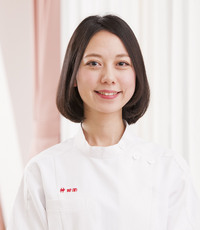
Megumi Kanda
Q: Why did you decide to become a practitioner of acupuncture, moxibustion, and anma/massage/shiatsu?
A: What started me down this path was I got considerable relief from manual therapies when I was suffering from some really bad low back pain.
Once I started receiving acupuncture and moxibustion treatments my chronic gynecological disorder also improved. Another big factor for me starting down this path was my desire to become licensed and learn how to perform treatments so I could help other suffering people.
Q: Why did you choose Toyoshinkyu?
A: Because at Toyoshinkyu you can learn traditional acupuncture and moxibustion, and you can learn from clinically practicing instructors with significant experience.
The range of special classes held outside of regular class time is also quite extensive, which was another appealing aspect of Toyoshinkyu.
Q: What do you think now that you are studying at Toyoshinkyu?
A: All of my classmates are highly knowledgeable and enthusiastic.
We are all friendly with each other and we help each other in our respective specialties. This makes it a really good environment for learning.
The teachers are also very kind and enthusiastic in their teaching. Teachers will work with us in the practicum training rooms until the very last minute during open hours after class.
The special lectures that are held on a regular basis feature lecturers who have been active in the acupuncture and moxibustion world for many years. Being able to receive direct instruction from these people is a truly invaluable experience.
Q: What are your post-graduation plans?
A: I would be pleased if I could open a small clinic focused on whole body treatments, a place where I could help women like me who are suffering with gynecological conditions.
Student Interview: Ken Sakamoto, Third Year, Acupuncture, Moxibustion, and Anma/Massage/Shiatsu Day Course
I want to continue providing clinical treatments until I am 70 years old
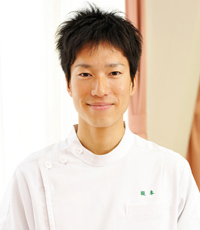
Ken Sakamato
Q: Why did you decide to become a practitioner of acupuncture, moxibustion, and anma/massage/shiatsu?
A: It started when I recovered from a sports injury through acupuncture, moxibustion, and massage treatments. I was shocked that the pain just went away even though there were no needles inserted into the area that was giving me pain. The whole person treatments unique to oriental medicine, treatments not just limited to the affected body part, were appealing to me.
Q: Why did you choose Toyoshinkyu?
A: Because I thought I wanted to learn traditional acupuncture and moxibustion treatments from clinically practicing teachers. I felt that Toyoshinkyu had extensive extracurricular classes and was the only place for me to polish my skills while in school. In addition, another big point for me was that the person who caused me to want to become a practitioner was a Toyoshinkyu graduate.
Q: What do you think now that you are studying at Toyoshinkyu?
A: The school as a whole has a serious atmosphere, making it a good environment to focus on studying. The studies are by no means easy, but the instructors enthusiastically teach us so I haven’t struggled at all. Average student age is also high and I think being able to study with people from many different backgrounds is another good aspect of Toyoshinkyu.
Q: What are your post-graduation plans?
A: I want open my own private practice within two years of graduating and I want to keep working as a clinical practitioner until I am 70 years old. I want to focus on the musculoskeletal system and support my patients in achieving their dreams.
Student Interview: Megumi Fujita, Third Year, Acupuncture, Moxibustion, and Anma/Massage/Shiatsu Night Course
Fujita is a veteran of volleyball and women’s baseball. After graduating from the Japan Women’s College of Physical Education, she worked as a ski instructor and fitness instructor before enrolling in Toyoshinkyu in April 2014.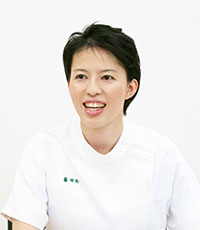
Fujita experienced a career change when she started her second year at Toyoshinkyu.
Currently, she works as a trainer at a fitness club and part time at an acupuncture, moxibustion, and seikotsu (osteopathic) clinic while she attends night classes. Changing careers allowed her to achieve a more balanced life rhythm and to study even harder. We had a chance to talk with her.
Fujita’s Daily Schedule
| 6:30-14:30 | Work | •Fitness club trainer •Part time work at an acupuncture, moxibustion, and seikotsu (osteopathic) clinic three days a week •Once work finishes, Fujita comes to Toyoshinkyu to study before classes start |
| 18:00-21:10 | Classes (After classes, she uses the practicum room open hours to practice her techniques) | |
| 00:00 | Return Home and Sleep | |
Q: Why did you decide to become a practitioner of acupuncture, moxibustion, and anma/massage/shiatsu?
A: I personally experienced acupuncture and moxibustion when I was injured during sports, which allowed me to realize its beneficial effects. Also, I love baseball. Watching trainers working all over the world kindled my interest so I decided to become a practitioner of acupuncture and moxibustion.
Q: Why did you choose Toyoshinkyu?
A: Before enrolling in Toyoshinkyu I went and visited a number of other schools. Actually, I was thinking about enrolling at another school. However, my thinking changed once I participated in the Toyoshinkyu trial school experience. I learned that I could study while focusing on meridian therapy and that there are a number of workshops and seminars with various instructors. A main reason I decided to enroll here was that through talking with Onoue-Sensei (a full time teacher at Toyoshinkyu) I got the feeling that the whole school works together to foster the development of clinical practitioners. Someone with more experience than me told me that in order to learn oriental medicine you need an environment that allows you to learn in depth. I thought Toyoshinkyu had an environment where I could really learn, so I decided to enroll.
Q: What are your post-graduation plans?
A: In a few years I think I’d like to move away from Tokyo and work as a clinical practitioner who can provide sports instruction.
Q: Your message for people considering enrolling in a school of acupuncture and moxibustion.
A: I think it is really good I enrolled at Toyoshinkyu. There are special classes and the curriculum is extensive. Toyoshinkyu has an environment where you can learn the attitude and skills of a clinical practitioner.
I experienced a career change as I was entering my second year. During this transition Ichikawa-Sensei, the teacher in charge of my class, and Ukita-San in the Career Consultation Room gave advice to me on multiple occasions. They kindly consulted with me and I was able to get some good advice.
Toyoshinkyu is a school where you can be at ease and focus on your studies. Of course Toyoshinkyu provides classes, but the school will also help when you are worried about balancing work and study, when you are thinking about a career change, or when you need support in work related matters.
Student Interview: Nobue Konishi, Second Year, Acupuncture, Moxibustion, and Anma/Massage/Shiatsu Night Course
After graduating from the Tokyo Metropolitan Saginomiya Senior High School, Konishi went to the Nippon Sport Science University. In April 2015, she enrolled in the Acupuncture, Moxibustion, and Anma/Massage/Shiatsu Night Course.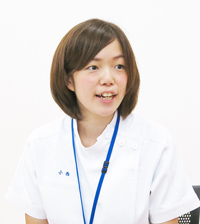
Nobue Konishi attends the night course while working two part time jobs to cover tuition and living expenses.
There are times when she does not just work before classes, but also after classes and on the weekends. Even though attending school with such time restrictions has its difficulties, Konishi says she is living a full life every day and she does not feel any stress!
We had a chance to talk with Konishi, who is living a busy life.
Konishi’s Daily Schedule
| 7:30 | Wake Up | |
| Commute to Work | ||
| 10:00 17:00 |
Work | Part time work at a restaurant and a relaxation salon in Shinjuku |
| Commute to School | Walk to Toyoshinkyu from her part time job | |
| 18:00 21:10 |
Classes | (Part time work after class about three days a week) |
| 22:00 | Study | Konishi finds it easier to focus on studying when she is outside her home so she studies until the last train and then returns home. |
| 1:00 | Return Home Sleep |
Q: Why did you decide to become a practitioner of acupuncture, moxibustion, and anma/massage/shiatsu?
A: When I was a university student I also was active as a sports trainer. My mentor was licensed to practice acupuncture, moxibustion, and anma/massage/shiatsu and becoming familiar with this made me feel I needed to obtain national qualifications myself. Amidst various national qualifications, I felt an appeal in helping people in a wide range of areas such as relaxation, so I decided to pursue becoming licensed in acupuncture and moxibustion.
Q: Why did you choose Toyoshinkyu?
A: I was attracted by the extensive technique instruction and the at-home atmosphere at Toyoshinkyu that other schools do not have. A major reason I chose Toyoshinkyu was I felt I could also learn the internal aspects necessary to become a practitioner.
The charm of Toyoshinkyu is in its school tradition of properly fostering future generations and in the fact that it is possible to learn from instructors who are active in a many different areas.
Q: What do you think now that you are learning at Toyoshinkyu?
A: Although there is a wide range of ages in the people studying together, everyone in the class is friendly, regardless of age. There are a lot of lecture style classes during the first year, but after that it is enjoyable because the amount of practicum classes keeps increasing.
Q: What are your post-graduation plans?
A: I want to treat many types of patients at a clinic and I also want to enter the sports and rehabilitation scene. Eventually, I want to be the kind of practitioner who has patients that come to the clinic and say, “I want Nobue Konishi to treat me.”
Q: Your message for people considering enrolling in a school of acupuncture and moxibustion.
A: I think there are a lot of different schools, but I feel Toyoshinkyu really values communication. The impression I got when I attended the trial school experience before enrolling has not changed now that I am attending Toyoshinkyu. I am glad I chose Toyoshinkyu, where I can learn not only the important skills to become a practitioner, but also learn about how to be kind as a person.
Student Interview: Toshihiko Naruishi, Second Year, Acupuncture, Moxibustion, and Anma/Massage/Shiatsu Night Course
Naruishi enrolled in a sports related vocational school after graduating from high school. Following his graduation from vocational school he worked in a hospital for about six years, and enrolled in Toyoshinkyu in April 2015 while continuing to work.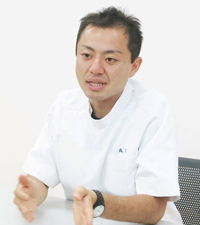
Toshihiko Naruishi attends the night course while continuing his medical and rehabilitation related work.
As soon as work finishes on weekdays he rushes to the Odakyu Line station and comes to Toyoshinkyu. Working relatively far from school, it seems his commute of about an hour gives him some problems.
We had the chance to talk with Naruishi, whose understanding workplace allows him to balance work and study.
Naruishi’s Daily Schedule
| 7:00 | Wake Up | |
| 8:30 | Commute to Work | |
| 16:30 | Finish Work | It is about one hour from work to school, so as soon as work finishes he really rushes to get to school. |
| Commute to School | ||
| 18:00 21:10 |
Classes | If he has time he will stay at school for the practicum room open hours or to study |
| 23:00 | Return Home | Prepare for the next day and take a bath |
Q: Why did you decide to become a practitioner of acupuncture, moxibustion, and anma/massage/shiatsu?
A: Originally, I was interested in anma and massage. When I was attending a vocational school for sports and health, an instructor who was licensed in acupuncture and moxibustion let me experience acupuncture and moxibustion. After that, becoming a practitioner of acupuncture and moxibustion was a natural decision for me.
Q: Why did you choose Toyoshinkyu?
A: I participated in the trial school experience and night practicum experience many times before enrolling. The experience of the acupuncture and moxibustion practicum, as well as experiencing a class, really made me feel the appeal of Toyoshinkyu. The talk from Onoue-Sensei (a full time teacher at Toyoshinkyu) on acupuncture, moxibustion, and oriental medicine left a particularly strong impression. I initially planned to visit some other schools but I thought “this is the place for me!” So, I didn’t visit other schools, decided on Toyoshinkyu, and took the AO entrance examination (a type of entrance examination in Japan where the admissions office interview carries great weight).
Q: What do you think now that you are learning at Toyoshinkyu?
A: I am able to thoroughly learn in class what I wanted to learn when I started. But, I am really struggling to make moxa cones and to insert needles straight… (laughs). Everyone in my class is very nice and friendly, and I always receive support from them.
Q: What are your post-graduation plans?
A: I want to utilize the skills I have learned in school to work diligently providing treatments. I want to treat many types of patients during my training and after graduation I want to work in a place I can perform acupuncture.
Q: Your message for people considering enrolling in a school of acupuncture and moxibustion.
A: I think there are a lot of people who feel that going to school while continuing to work might be difficult. Actually, I worried whether I would be able to do both. However, “you can do it if you try.” Even though time is limited and there are some difficulties, you will be able to focus on your studies if you are firm in your objective and can get the understanding of your workplace and the people around you.
Detailed Information on Entrance Exams and Tuition
• Entrance Exam Details (Japanese)
• Tuition and Student Loans (Japanese)
• School Information Session (Japanese)


